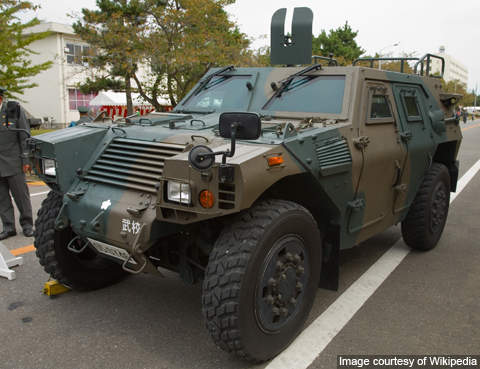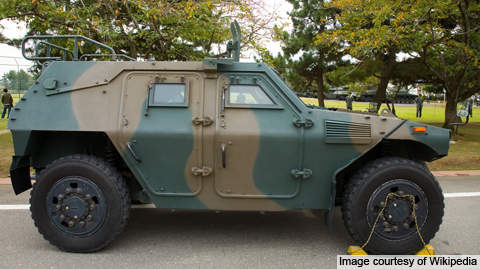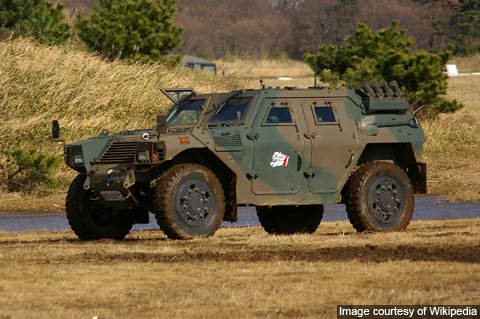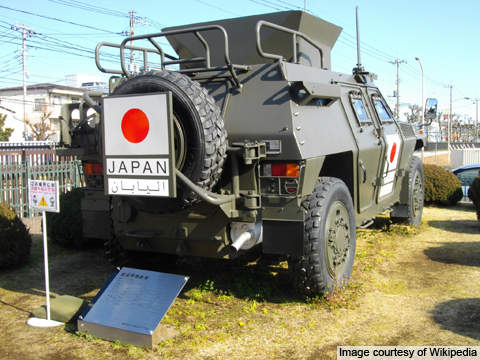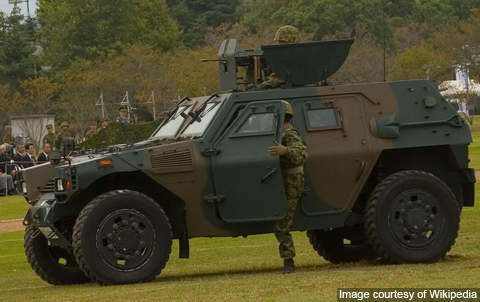Komatsu LAV (light armoured vehicle) is in service with the Japan Ground Self Defence Forces (JGSDF). Introduced in 2002, the vehicle was deployed in the Iraq War. The LAV is produced by the Komatsu Defence Systems Division in Komatsu, Japan. The vehicle bears a passing resemblance to the Panhard VBL, which is in service with the French Army.
The Komatsu LAV is used to transport armoured infantry troops in the battlefield. Equipped with specific weapons, the vehicle provides light armoured mobility. The LAV entered service with JGSDF in 2002. It was deployed by the JGSDF in 2004 for its troops stationed in Iraq. Over 1,000 vehicles were built for JGSDF, but the LAV was not offered to any export customer.
Komatsu LAV development
The Komatsu LAV was developed by the Office of Research and Defence in 1997 to meet the requirement of the JGSDF for a light armoured wheeled vehicle that could provide better armoured mobility. The vehicle replaced the HMV Hayate and Type 73 small utility vehicles as they were not capable of providing protection against small arms fire.
Komatsu LAV design and features
The LAV design incorporates a welded steel armour construction on a chassis fixed to 4×4 wheel configuration. It has an overall length of 4.4m, width of 2.04m and overall height of 1.85m. The empty weight is 4,500kg. The vehicle can accommodate four crew members.
The driver and infantry man facing two large bullet proof main windows can enter and exit the vehicle from forward opening doors on either side of the vehicle. A roof hatch is provided to access the weapon stations.
The individual seating arrangement houses two soldiers sitting in the back. They can access the vehicle using two doors available on either side. A single door on the rear side is fitted with an additional run flat tyre. Each door is fitted with a bullet proof window and provides a clear view to the infantry men sitting inside the vehicle. The vehicle is also equipped with a fire extinguisher.
Armament
The LAV is armed with a Sumitomo M249 LMG (light machine gun) or a Sumitomo M2HB 12.7mm machine gun for anti-personnel missions. It can also be mounted with the Type 01 LMAT man-portable fire-and-forget anti-tank missile or a Kawasaki Type 87 anti-tank missile for anti-armoured roles.
The weapon systems fitted on the vehicle are surrounded with an armoured turret to protect the gunner. The vehicle also features a pintle-mounted turret and two smoke grenade launchers on the rear side.
Self-protection
The Komatsu LAV features a welded steel armour body structure. It can withstand regular 5.56mm fire and light machine gun fire. Sources indicate that the armour protection of Komatsu LAV is better than that of up-armoured HMMWV.
Some of the vehicles are also fitted with unusual roof-mounted shielding. The open-split roof hatch of the vehicle provides additional protection to the gunner from all directions. The vehicles deployed in Iraq are fitted with reinforced bulletproof windshields. Some of them are also fitted with wire cutters and a rotational armoured cover around the gun mount for extra protection.
Propulsion
The Komatsu LAV is fitted with a liquid cooled 4-cycle diesel engine of 160hp. The power pack is mounted centre forward of the vehicle to distribute weight more evenly between the axles. The propulsion system provides a top speed of 100km/h.
Mobility
The LAV can travel more than 200 miles without refuelling. It is fitted with all run-flat tyres. The low turning radius allows the vehicle to negotiate narrow passages.
The vehicle can be carried inside some military helicopters and under slung CH-47J or C-130H transport aircraft for emergency air-drops. It can be airdropped from transport aircraft by use of a parachute platform.

